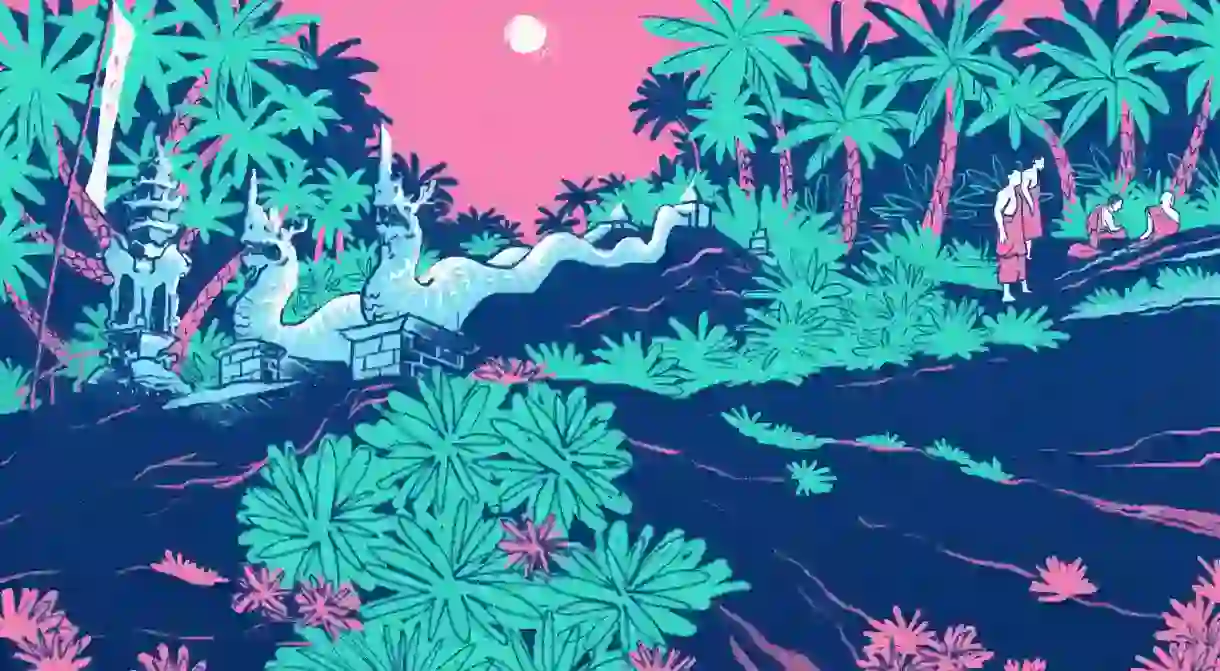A Guide to Chiang Mai’s Forest Monasteries

Anyone who has visited Chiang Mai knows the city is all about its monasteries. Magnificent Lanna-style wat line the orderly lanes of the walled Old City, dripping with tiled mosaics and gilded dragons, like jewellery boxes blown up to city-block size.
Monasteries such as elegant Wat Phan Tao, with its tall teak pillars, and Wat Chedi Luang, with its towering broken stupa, are essential stops on the tourist trail, but the crowds slow to a trickle once you leave the centre and head out to Chiang Mai’s charming forest wat, which offer a calmer window onto Thailand’s Buddhist soul.
Charter one of Chiang Mai’s rót daeng (red trucks) for the day, and you can explore a mesmerising world of rainforest-flanked stupas, mystical legends and gleaming gold spilling spires out of the jungle. Make time for the following monasteries scattered like lost jewels around the suburbs and hills surrounding the northern Thai capital.
Wat U Mong
Monastery

West of the Old City, Wat U Mong is a proper forest wat, with its stupas and monks’ quarters scattered through a sprawling tangle of tropical trees. This venerable complex wears its 700-year age on its sleeve, and its buildings are nibbled by the centuries and fringed by foliage, adding to the air of antiquity. Beneath the towering main chedi (stupa) is a squat structure worm-holed by a warren of passageways decorated with murals of forest scenes, built in the 13th-century on the orders of King Mengrai, founder of the Lanna kingdom. This ancient maze was reputedly constructed to distract a revered but deranged monk named Thera Jan, who had a habit of wandering off into the jungle in the grip of religious trances. A more recent curiosity is the pack of English bull terriers, raised by the resident monks, who loll lazily around the monks’ cells at the edge of the forest.
Wat Phra That Doi Suthep
Monastery

No list of Chiang Mai monasteries would be complete without a mention of Wat Phra That Doi Suthep, which paints the upper slopes of Doi Suthep mountain in spangles of reflected gold. Perhaps the definitive Northern Thai wat, this sacred structure was built to enshrine one of Thailand’s most important relics – a shoulder bone from the historical Buddha – which broke apart mysteriously at the base of the mountain. Reading this as an omen, monks attached half of the relic to a sacred white elephant, which wandered the mountainside until it died, marking the spot where the monastery was founded. Everyone knows about this iconic monastery and its gleaming, gold-plated stupa, but the atmosphere is still surprisingly meditative, despite the throng of visitors. Part of the thrill of visiting Wat Phra That Doi Suthep is getting here – by rót daeng, rented motorcycle or mountain bike, on a winding road that becomes increasingly lush and green as you climb above the city skyline, or on foot on a muddy trail starting behind Chiang Mai Zoo.
Wat Suan Dok
Monastery

The other half of the Doi Suthep shoulder-bone relic was enshrined at dignified Wat Suan Dok, west of the Old City on the road to Chiang Mai University. Most Chiang Mai monasteries are centred on angular, Lanna-style stupas, but Suan Dok features a rounded, bell-shaped chedi, surrounded by a garden of white, funerary stupas containing the ashes of members of the Lanna royal family. This part of Chiang Mai was covered by flower gardens when the monastery was founded in the 14th century, and it’s still a peaceful spot, despite the periodic bursts of noise from nearby Chiang Mai airport. Many Chiang Mai Buddhists are former students of the Mahachulalongkornrajavidyalaya Buddhist University in the grounds; drop by for the daily monk chat on weekday afternoons, when you can quiz resident monks on the details of life in the sangha (Buddhist brotherhood).
Wat Phra That Doi Kham
Monastery

Far from the maddening crowds, but not all that far from the city limits, Wat Phra That Doi Kham is reached by a soaring naga (serpent) stairway that climbs above the western suburbs, on the lower slopes of Doi Suthep mountain. Local legend has it that this lofty eyrie, crowned by a 17m-high (56ft-high) seated Buddha in golden robes, was once the home of a pair of cannibal giants, who were convinced to give up their wicked ways following an intervention by the Buddha. The glimmering chedi (stupa) at the heart of the compound enshrines a strand of hair that the Buddha left as a reminder to the reformed monsters. Views, as you might expect, are spectacular, and the monastery is the focal point for a string of local festivals, tied to the independent Lanna rulers who governed this region before the unification of Thailand in the 18th century.
Wat Jet Yot
Buddhist Temple, Ruins

Wat Pha Lat
Hiking Trail, Monastery

Often overlooked in the rush to reach Wat Phra That Doi Suthep, sleepy Wat Pha Lat – aka Wat Palad – is a moss-encrusted garden of Buddhist sculptures, reached by a muddy trail through the Doi Suthep jungle. Walkways are flanked by teppanom (protector guardians) with lion or serpent bodies, sing (guardian lions) protect the main stupa, and all sorts of oddities poke up amidst the foliage, from Garuda fighting a snake to a mock-up spire from the Bayon at Angkor Wat in Cambodia. Marked by lengths of orange cloth tied around trees, the steep path to the monastery starts behind Chiang Mai Zoo and climbs through dense forest, emerging by a forest waterfall and a naga stairway climbing to the monastery entrance. With the serene, green setting, it’s a fine spot to contemplate the nature of existence, and committed temple fans can continue the hike to Wat Phra That Doi Suthep, an hour further along the ridge.













